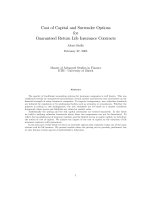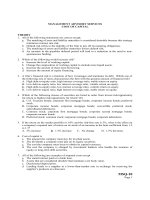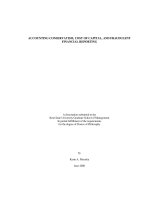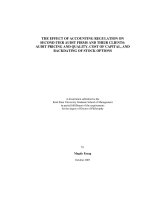Business finance ch 9 cost of capital
Bạn đang xem bản rút gọn của tài liệu. Xem và tải ngay bản đầy đủ của tài liệu tại đây (127.71 KB, 37 trang )
CHAPTER 9
The Cost of Capital
Sources of capital
Component costs
WACC
Adjusting for flotation costs
Adjusting for risk
9-1
What sources of long-term
capital do firms use?
Long-Term Capital
Capital
Long-Term
Long-Term Debt
Debt Preferred
Preferred Stock
Stock Common
Common Stock
Stock
Long-Term
Retained Earnings
Earnings
Retained
New Common
Common Stock
Stock
New
9-2
Calculating the weighted
average cost of capital
WACC = wdkd(1-T) + wpkp + wcks
The w’s refer to the firm’s capital
structure weights.
The k’s refer to the cost of each
component.
9-3
Should our analysis focus on
before-tax or after-tax capital
costs?
Stockholders focus on A-T CFs.
Therefore, we should focus on A-T
capital costs, i.e. use A-T costs of
capital in WACC. Only kd needs
adjustment, because interest is tax
deductible.
9-4
Should our analysis focus on
historical (embedded) costs or
new (marginal) costs?
The cost of capital is used
primarily to make decisions that
involve raising new capital. So,
focus on today’s marginal costs
(for WACC).
9-5
How are the weights
determined?
WACC = wdkd(1-T) + wpkp + wcks
Use accounting numbers or market
value (book vs. market weights)?
Use actual numbers or target
capital structure?
9-6
Component cost of debt
WACC = wdkd(1-T) + wpkp + wcks
kd is the marginal cost of debt
capital.
The yield to maturity on outstanding
L-T debt is often used as a measure
of kd.
Why tax-adjust, i.e. why kd(1-T)?
9-7
A 15-year, 12% semiannual
coupon bond sells for
$1,153.72. What is the cost of
debt (kd)?
Remember, the bond pays a
semiannual coupon, so kd = 5.0% x
2 = 10%.
INPUTS
30
N
OUTPUT
I/YR
-1153.72
60
1000
PV
PMT
FV
5
9-8
Component cost of debt
Interest is tax deductible, so
A-T kd = B-T kd (1-T)
= 10% (1 - 0.40) = 6%
Use nominal rate.
Flotation costs are small, so ignore
them.
9-9
Component cost of preferred
stock
WACC = wdkd(1-T) + wpkp + wcks
kp is the marginal cost of
preferred stock.
The rate of return investors
require on the firm’s preferred
stock.
9-10
What is the cost of preferred
stock?
The cost of preferred stock can be
solved by using this formula:
kp = Dp / Pp
= $10 / $111.10
= 9%
9-11
Component cost of preferred
stock
Preferred dividends are not taxdeductible, so no tax adjustments
necessary. Just use kp.
Nominal kp is used.
Our calculation ignores possible
flotation costs.
9-12
Is preferred stock more or
less risky to investors than
debt?
More risky; company not required
to pay preferred dividend.
However, firms try to pay preferred
dividend. Otherwise, (1) cannot
pay common dividend, (2) difficult
to raise additional funds, (3)
preferred stockholders may gain
control of firm.
9-13
Why is the yield on preferred
stock lower than debt?
Corporations own most preferred stock,
because 70% of preferred dividends are
nontaxable to corporations.
Therefore, preferred stock often has a
lower B-T yield than the B-T yield on debt.
The A-T yield to an investor, and the A-T
cost to the issuer, are higher on preferred
stock than on debt. Consistent with
higher risk of preferred stock.
9-14
Illustrating the differences
between A-T costs of debt and
preferred stock
Recall, that the firm’s tax rate is 40%, and its
before-tax costs of debt and preferred stock
are kd = 10% and kp = 9%, respectively.
A-T kp = kp – kp (1 – 0.7)(T)
= 9% - 9% (0.3)(0.4)
A-T kd = 10% - 10% (0.4)
= 7.92%
= 6.00%
A-T Risk Premium on Preferred = 1.92%
9-15
Component cost of equity
WACC = wdkd(1-T) + wpkp + wcks
ks is the marginal cost of common
equity using retained earnings.
The rate of return investors
require on the firm’s common
equity using new equity is ke.
9-16
Why is there a cost for
retained earnings?
Earnings can be reinvested or paid out as
dividends.
Investors could buy other securities, earn a
return.
If earnings are retained, there is an
opportunity cost (the return that stockholders
could earn on alternative investments of
equal risk).
Investors could buy similar stocks and earn ks.
Firm could repurchase its own stock and earn ks.
Therefore, ks is the cost of retained earnings.
9-17
Three ways to determine
the cost of common
equity, ks
CAPM: ks = kRF + (kM – kRF) β
DCF:
Own-Bond-Yield-Plus-Risk Premium:
ks = kd + RP
ks = D1 / P0 + g
9-18
If the kRF = 7%, RPM = 6%, and the
firm’s beta is 1.2, what’s the cost of
common equity based upon the
CAPM?
ks = kRF + (kM – kRF) β
= 7.0% + (6.0%)1.2 = 14.2%
9-19
If D0 = $4.19, P0 = $50, and g = 5%,
what’s the cost of common equity
based upon the DCF approach?
D1 = D0 (1+g)
D1 = $4.19 (1 + .05)
D1 = $4.3995
ks = D1 / P0 + g
= $4.3995 / $50 + 0.05
= 13.8%
9-20
What is the expected future growth
rate?
The firm has been earning 15% on equity
(ROE = 15%) and retaining 35% of its
earnings (dividend payout = 65%). This
situation is expected to continue.
g = ( 1 – Payout ) (ROE)
= (0.35) (15%)
= 5.25%
Very close to the g that was given before.
9-21
Can DCF methodology be
applied if growth is not
constant?
Yes, nonconstant growth stocks are
expected to attain constant growth
at some point, generally in 5 to 10
years.
May be complicated to compute.
9-22
If kd = 10% and RP = 4%, what is ks
using the own-bond-yield-plus-riskpremium method?
This RP is not the same as the
CAPM RPM.
This method produces a ballpark
estimate of ks, and can serve as a
useful check.
ks = kd + RP
ks = 10.0% + 4.0% = 14.0%
9-23
What is a reasonable final
estimate of ks?
Method
CAPM
DCF
kd + RP
Average
Estimate
14.2%
13.8%
14.0%
14.0%
9-24
Why is the cost of retained earnings
cheaper than the cost of issuing new
common stock?
When a company issues new common
stock they also have to pay flotation
costs to the underwriter.
Issuing new common stock may send
a negative signal to the capital
markets, which may depress the stock
price.
9-25









